
Winter sports or winter activities are competitive sports or non-competitive recreational activities which are played on snow or ice. Most are variations of skiing, ice skating and sledding. Traditionally, such games were only played in cold areas during winter, but artificial snow and artificial ice allow more flexibility. Playing areas and fields consist of either snow or ice.

The 1968 Winter Olympics, officially known as the X Olympic Winter Games, were a winter multi-sport event held from 6 to 18 February 1968 in Grenoble, France. Thirty-seven countries participated. Frenchman Jean-Claude Killy won three gold medals in all the alpine skiing events.

The 1960 Winter Olympics were a winter multi-sport event held from February 18 to 28, 1960, at the Squaw Valley Resort in Squaw Valley, California, United States. The resort was chosen to host the Games at the 1956 meeting of the International Olympic Committee (IOC). Squaw Valley was an undeveloped resort in 1955, so the infrastructure and all of the venues were built between 1956 and 1960 at a cost of US$80,000,000. The layout was designed to be intimate, allowing spectators and competitors to reach most of the venues on foot.

The 1964 Winter Olympics, officially known as the IX Olympic Winter Games and commonly known as Innsbruck 1964, was a winter multi-sport event which was celebrated in Innsbruck, Austria, from January 29 to February 9, 1964. The city was already an Olympic candidate, unsuccessfully bidding to host the 1960 Games. Innsbruck won the 1964 Games bid, defeating the cities of Calgary in Canada and Lahti in Finland. The sports venues, many of which were built for the Games, were located within a radius of 20 km (12 mi) around Innsbruck. The Games included 1,091 athletes from 36 nations, which was a record for the Winter Games at the time. Athletes participated in six sports and ten disciplines which bring together a total of thirty-four official events, seven more than the 1960 Winter Olympic Games. The luge made its debut on the Olympic program. Three Asian nations made their Winter Games debut: North Korea, India and Mongolia.
Figure skating at the 1960 Winter Olympics took place at the Blyth Arena in Squaw Valley, California, United States. Three figure skating events were contested: men's singles, ladies' singles and pair skating.

Canada Olympic Park (COP), formerly known as Paskapoo Ski Hill, is a ski hill and multi-purpose training and competition facility located in Calgary, Alberta, Canada, owned and operated by WinSport. It is currently used both for high performance athletic training and for recreational purposes by the general public. Canada Olympic Park was one of the venues for the 1988 Winter Olympics, being the primary venue for ski jumping, bobsleigh, and luge.
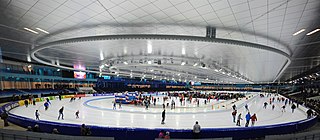
Thialf is an ice arena in Heerenveen, Netherlands. Thialf consists of the Thialf-hal and the Elfstedenhal. Thialf is used for long track speed skating, short track speed skating, ice hockey, figure skating, ice speedway, and non-sporting events. The outdoor rink was opened in 1967, and the indoor stadium was opened in 1986. Several world records have been set in the indoor stadium.

Australia competed at the 1960 Winter Olympics in Squaw Valley, United States. This was the first and last time Australia competed in ice hockey and Nordic combined. While ice hockey gave Australia its only top ten finish in this games, the team lost all of their matches, conceding double-digit goals. Australia also competed in alpine skiing, cross-country skiing, and figure skating, where Mervyn Bower and Jacqueline Mason came twelfth in the pairs event.
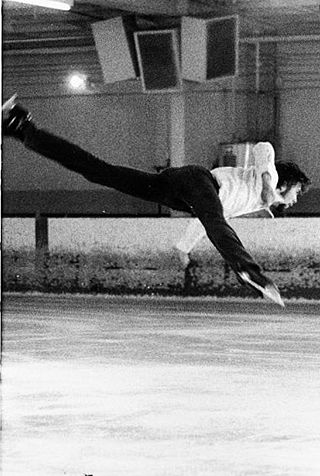
Robert Bradshaw was an American figure skater. He won gold medals at the 1972 Nebelhorn Trophy and International St. Gervais. He placed 12th at the 1973 World Championships.

The XXV Winter Universiade, took place in Erzurum, Turkey between 27 January to 6 February. Erzurum is the city at the highest altitude in Turkey, at 1,850 m (6,070 ft), and has over 320 cultural landmarks. Located in Eastern Anatolia Region, it is a city on the traditional silk road and has been governed by many cultures over the centuries. The Erzurum Ice Hockey Arena, located on the Cemal Gürsel Sports Campus, was newly built with an ice rink of 60m x 30m and 3,000 seats for spectators.

The University of Illinois Ice Arena, also known as the Big Pond, is an ice arena and recreational sports facility in Champaign, Illinois, and owned and operated by the University of Illinois at Urbana–Champaign. The arena is the home for the Illinois Fighting Illini men's and women's college ice hockey teams competing in the American Collegiate Hockey Association. The men's ice hockey team competes at the ACHA Division I level as a member of the Central States Collegiate Hockey League and the women's team competes independently. Illinois also has an ACHA Division II team that plays in the Mid American Collegiate Hockey Association. Additionally, the facility is the home of the Illinois synchronized skating Team, the Illinois Intercollegiate Figure Skating Team and several skating clubs such as the Champaign Regional Speed Skating Club, Ice Cubes Youth Synchronized Skating and the Champaign-Urbana Youth Hockey Association.
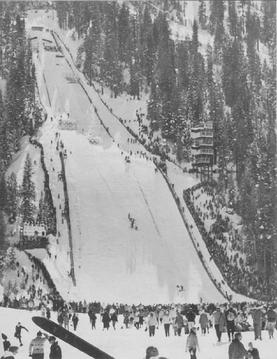
Papoose Peak Jumps was a ski jumping hill located at Palisades Tahoe in the US state of California. The hill consisted of three jumps, with K-points of 80, 60 and 40 meters, respectively. Constructed upon the hill-side of Little Papoose Peak, it was built for the 1960 Winter Olympics; the 80-meter hill hosted the ski jumping event and the 60-meter hill the Nordic combined event. The jump was designed by Heini Klopfer and opened in 1958. After the Olympics the venue saw little use; it was renovated for the 1976 US National Ski Jumping Championships, but has since fallen into disrepair and demolished to make room for the Far East Express ski lift.

The Squaw Valley Olympic Skating Rink was a temporary venue constructed for the 1960 Winter Olympics in Olympic Valley, California. Located outdoors near the Blyth Arena, it hosted the speed skating and some of the ice hockey events for those games. The site has been re-developed as parking and mixed residential-retail complex.
For the 1960 Winter Olympics in Squaw Valley, California, in the United States, a total of five sports venues were used. Except for the Palisades Tahoe, all of the venues had to be constructed. For the first time in Winter Olympic history, a temporary venue was constructed at McKinney Creek for biathlon, cross-country skiing, and Nordic combined. A bobsleigh track was not constructed over the guarantees from the FIBT not being able to field the minimum twelve teams needed to compete, making it the only time bobsleigh has not been included in the Winter Olympics.
The 2011 South Asian Winter Games, officially the 1st South Asian Winter Games, were held in Dehradun and Auli, in the Himalayan state of Uttarakhand, India in January 2011. The games were conducted by the Indian Olympic Association and the Winter Games Federation of India. A grand opening and closing ceremony took place on 10 January 2011 and 16 January 2011, in Dehradun and Auli, respectively.
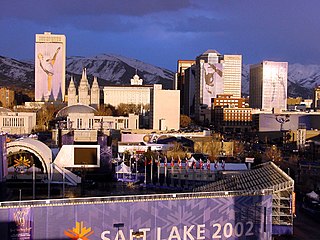
The 2002 Winter Olympic Games were held in and around Salt Lake City, United States from February 8 to 24, 2002, and the Paralympics from March 7 to 16, 2002. The sporting events were held in ten competitive venues, while non-competitive events, such as the opening ceremony, were held in six other venues. Three venues were also created for training purposes. All Olympic venues were scattered throughout Northern Utah and the Wasatch Front.

Lviv 2022 was a bid by the city of Lviv and the National Olympic Committee of Ukraine for the 2022 Winter Olympics. Lviv withdrew its bid on 30 June 2014. The IOC ultimately selected Beijing as the host city for the 2022 Winter Olympics at the 128th IOC Session in Kuala Lumpur, Malaysia on 31 July 2015.
The pair skating competition of the 1960 Winter Olympics was held at the Blyth Arena in Squaw Valley, California, United States. The event took place on Friday 19 February 1960. Each judge ranked the skaters by Ordinal Placement from first to last place. If a skater was ranked first by a majority of the judges, that skater was placed first overall; this process was repeated for each place. If more than one skater had a majority ranking for the same position, then a series of tiebreaks were in place, indicated in order in the Results section below.
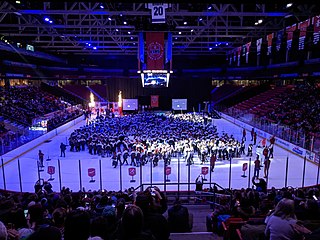
The Olympic Center is a sports complex in Lake Placid, New York that acted as the Olympic Park for both the 1932 and the 1980 Winter Olympics. The venues inside this area is the main complex of the 2023 Winter World University Games.


















